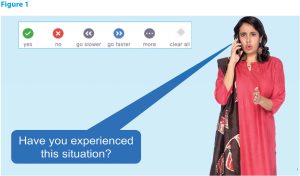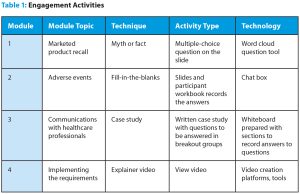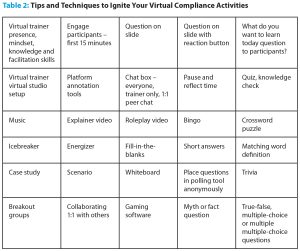Technology – By Liz Wool
Yes, you can deliver compelling compliance lessons
Aargh, compliance training! Is this the response that you get from people when they’re signing up or assigned to your training? Or perhaps it’s your reaction when you take compliance training?
Igniting virtual compliance training is within everyone’s ability, even with internal firewalls and various security settings. That’s especially so when you utilize robust virtual instructional design and the advancement of software technologies (such as virtual training platforms and third-party applications).
As with in-person training, some students will not ask or answer questions. Many of the techniques explained here boost their participation and learning such as using tools with anonymity features, like polls and word clouds.
You can deliver compelling and engaging virtual compliance training. Trainers must know two “big whys” as they prepare and deliver their training:
- The why for the course.
- The why for participants. (What’s in it for me and how will this training benefit my job role?)
This article shares with you practices that can ignite your virtual training activities and course to success and participant accolades.
The No. 1 Success Factor No One Tells You About
The virtual trainer is the No. 1 success factor for igniting engagement with a compliance training course. In addition to the virtual space setup (lighting, camera, microphone), the virtual trainer’s presence is the wow factor – smiling, great mindset, enthusiastic to be the trainer, welcoming and conversational manner, promoting trust and psychological safety.
People come to learn from you! Your participants will recognize that your goal is their success. Express sincere interest in teaching the topic and come ready with relevant examples and stories.
In compliance training, participants will remember your stories for years afterward, versus all of the course content. These techniques bring compliance training to life and transcend the virtual space that fosters understanding, evaluating and synthesizing the material and learning that will be used after the training. A great tip to connect and build trust with participants when answering questions is to just open up the camera and stop sharing the slides.
Another great technique brings your head out of the box. Stand up as you train, speaking using your diaphragm, while using your arms, hands, facial expressions and body position to engage and connect with your participants through the camera. It’s like you were standing right in front of your class.
You can set the stage for a great course, at the very beginning, by capturing participants’ attention and creating connections with them.
The First 15 Minutes: Key for Setting the Stage
Ignite your virtual classroom training within the first 15 minutes to harness interest, curiosity and participation. Focus on the environment, people, connection and YOU.
The virtual trainer is the cheerleader, emcee and welcoming team. Play upbeat music as people enter as you welcome each person by name with a smile and enthusiasm. Begin by saying, “I’m so excited to teach you this compliance training today because we are going to make it real and applicable to your role.” Be very specific about why you’re excited to be their trainer.
Here is a helpful technique to gauge this approach and energy level: Imagine you see your best friend on a street corner and you haven’t seen them in a month –feel this excitement and joy and bring it to class. Let people see your passion for training.
To engage people, before you review the agenda and learning objectives askthese questions:
- What do you want to learn today?
- What are some of the challenges you encounter with this requirement?
- What are your burning questions regarding this requirement?
Give participants a few minutes to think about their answer. Tell them you are moving them to a breakout for three minutes to discuss their answers with one another.
As you bring everyone back into class together, show a word cloud generator on a slide with at least one of the questions. Ask everyone to enter their answers –generating a word cloud for that question/answer. Review and debrief with participants.
This creates the personal connection with their classmates and you, sharing like thoughts, needs, insights or experiences. Now you can transition into your opening that includes the course’s why (the reasons and benefits) for them and what they will learn to use after the course in their role.
Engagement With Purposeful Participation
Virtual training approaches include purposeful engagement and participation every five minutes or so. This benchmark comes from Association for Training and Development (ATD) and other virtual training providers.
Purposeful participation is planned engagement and activities that align with the course’s why and learning. Purposeful participation can be social (icebreakers, energizers and working with others), cognitive (sharing thoughts or expertise, testing current level of knowledge and knowledge gained, critical thinking, problem-solving), behavioral (being calm during a regulatory authority inspection interview) or physical skills (using a fire extinguisher correctly).
By focusing on these elements for purposeful participation, virtual training interactions will be planned, frequent and with a purpose to ignite interest and participation during the course.
Questioning Techniques
Not everyone learns or remembers auditory instructions or questions posed to them. Many people, like myself, will write down the questions and their answers.
To ignite participation, write the question on the slide. Provide three minutes for the participants to think what the answer should be. This is critical for people who process information at a different pace or who may be neurodivergent.
The answers can be provided in a variety of ways: breakout groups to discuss (with or without whiteboards recording the answers), word clouds, annotation tool, chat box or open microphones.
The virtual trainer debriefs the activity to provide positive reinforcement or provide direction and guidance for misunderstandings or incorrect answers.
Ignite questions from participants by using the anonymous “ask a question” feature in the polling software application tool.
These techniques get your quiet, shy, introverted, inexperienced and extroverted participants to both answer questions and ask questions anonymously that ignite their participation.
Sharing Experiences – Avoid the Silence
Avoid the deafening silent room when you ask a question. Place the question on the slide with visuals. Use a PowerPoint cutout figure and a bubble cloud that has the question in it, as shown in
Figure 1.
Include an image of the reaction button of yes or no icons on the slide. Ask the participants, “Have you experienced this situation?” Give a green check for yes or a red X for no. The green check indicates the participant has experienced this situation and would be willing to share with everyone. Call on those individuals with a green check to share their experiences.
Variety – No Boredom!
When using breakout groups, use a whiteboard and identify how you want the answers portrayed (per the activity instructions). For instance, as process mapping, brainstorming, problem-solving case study, scenarios, answering questions, recording experiences, lining up the process on the whiteboard and what needs to happen to go to the next step or answering role-play questions. Develop these whiteboards ahead of time for ease of execution in the class. Some software applications come with premade templates for a whiteboard (e.g., system design, process maps, design thinking).
Replace polls or questions to be answered in the chat box with alternative methods such as short answers, fill-in-the-blanks (great for experienced staff), trivia, matching definition to the word, crossword puzzle, word cloud and game software with or without leader boards.
Include pauses and reflection time minimally at the end of a section and/or throughout. This gives time for everyone to stop listening to the information to absorb, synthesize, evaluate and think about the material in context and what it means to them, their team, their department and all roles involved.
In your course outline, add a column that states what type of engagement activity you are using for each section or topic. At a glance, you can identify if you have great variety, or if a lot of similar techniques are used sequentially during the course. (See Table 1.)
Course or Section Opening
Open up the course or course section with any of the following:
- Explainer video that provides the key information in a video format with or without music overlay.
- Discuss after the video that these are the elements of what you will be talking about next.
- You can use a PowerPoint format, or a people with text overlay format.
- When delivering virtual compliance training, often the training addresses how to implement the requirements.
Myth or Fact?
These questions are useful for both experienced and inexperienced participants. Post a true or false, multiple-choice or multiple multiple-choice question on the slide. (See Figure 2.)
- Have the question be scenario-based. This ignites critical thinking and directly correlates to the implementation of the compliance requirements.
- Responses are viewed on the screen, and not the chat box, as this allows formaximum impact. Everyone understands the level of experience andexpertise in the class.
- The virtual trainer reviews both the right and the wrong answers with the rationale, including the compliance requirements, because some people might have guessed successfully
- This can be designed very specifically for knowledge or skill gaps within your organization, as it is useful for people to learn in a respectful manner that they have been doing things incorrectly.
In Closing
Using these techniques and tools transforms routine virtual compliance training to engage, connect and harness participation. The virtual trainer witnesses the extrovert, introvert, shy or inexperienced participants participate, learn and apply the course material to the designated course learning and performance outcomes.(See Table 2).
And, finally, the participant and virtual trainer experience satisfaction and connection with the training course and one another that is replicated in all of the virtual compliance training courses.
 Liz Wool, FACRP, CCRA, CID, CMT, is principal of Wool Consulting Group. Email Liz at liz@woolcg.com.
Liz Wool, FACRP, CCRA, CID, CMT, is principal of Wool Consulting Group. Email Liz at liz@woolcg.com.












